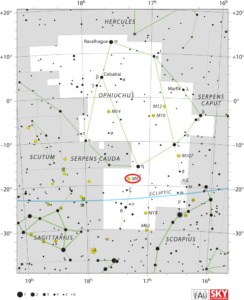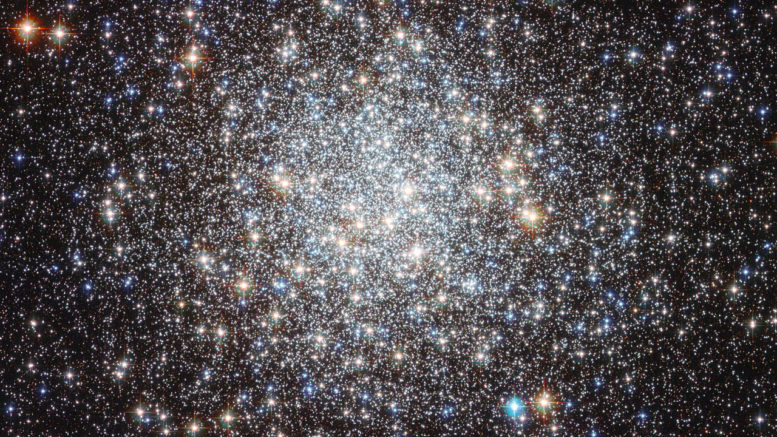Messier 9 is one of the nearest globular clusters to the centre of the Milky Way, lying 5,500 light years from the center of the Milky Way. Therefore, as a result, M9 will appear a bit flattened due to the gravitational influence of the Milky Way core.
| Description | |
| Visible From Pacific Northwest | early AM in March to early evening September |
| Best Time To Observe | July |
| Minimum Size Of Viewing Device | Larger Binoculars or Telescope |
| Object Type | Globular Cluster |
| Designations | Messier 9, M9, NGC 6333, ESO 587-SC 005, h 1979, h 3677 |
| Right Ascension | 17h 19m 11.78s |
| Declination | -18°30’58.5” |
| Constellation | Ophiuchus |
| Absolute magnitude | -8.04 |
| Apparent magnitude | +8.42 |
| Apparent dimensions | 12′ |
| Object Radius | 45 Light Years |
| Distance From Earth | 25,800 light years |
History
The cluster was discovered by French astronomer Charles Messier on June 3, 1764, who described it as a “nebula without stars”. In 1783, English astronomer William Herschel was able to use his reflector to resolve individual stars within the cluster. He found the cluster to be 7−8′ in diameter with stars densely packed near the center.
Locating M9 In The Sky
Unfortunately, there is no easy way to locate M9. The constellation of Ophiuchus is sprawling and it will take some practice to identify Eta. Once you do, you’ll find this small globular cluster about 3 degrees (two finger widths) to the southeast. Look for a small triangular formation of stars and aim slightly above the southernmost.

Viewing M9
While M9 is achievable in binoculars, keep in mind that low magnifying powers and aperture, such as 6X30 models, will mean the image you will see is tiny and you’ll have to keep your binoculars steady to pick it out of the field. Larger models will improve the situation, but you’ll need dark skies to capture this Messier without more power. In a small telescope, M9 will still have difficulty resolving – but will show hints of a concentrated core region. As you approach the 6″ and larger range, resolution begins and large aperture scopes can fully resolve this loosely constructed globular cluster fully.
Photographing M9
It is possible to use a DSLR, but will require accurate guidance. There isn’t much that one can find for assistance for finding recommendations for details about how to photograph this globular cluster. There are several websites that have photos, but none that really would assist an astrophotographer.
Sources And Further Reading
Descriptions of all of Messier Objects can be found here.

Be the first to comment on "Messier 9"